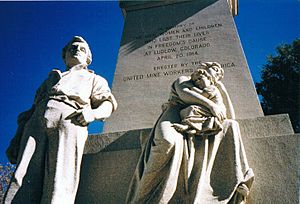Colorado Coalfield War facts for kids
Quick facts for kids Colorado Coalfield War |
|||
|---|---|---|---|
| Part of the Coal Wars | |||
|
Clockwise from top left:
|
|||
| Date | First stage: September 23, 1913 – April 20, 1914 Ten Days War: April 20, 1914 – April 30, 1914 Final stage: April 29, 1914 – December 1914 |
||
| Location | |||
| Resulted in | Strike failed
|
||
| Parties to the civil conflict | |||
|
|||
| Lead figures | |||
|
|||
| Number | |||
|
|||
| Casualties | |||
|
|||
| Total deaths, including Ludlow Massacre: 69 – 199 | |||
The Colorado Coalfield War, was a major labor uprising in the Southern and Central Colorado Front Range between September 1913 and December 1914. Striking began in late summer 1913, organized by the United Mine Workers of America (UMWA) against the Rockefeller-owned Colorado Fuel and Iron (CF&I) after years of deadly working conditions and low pay. The strike was marred by targeted and indiscriminate attacks from both strikers and individuals hired by CF&I to defend its property. Conflict was focused in the southern coal-mining counties of Las Animas and Huerfano, where the Colorado and Southern railroad passed through Trinidad and Walsenburg. It followed the 1912 Northern Colorado Coalfield Strikes.
Tensions climaxed at the Ludlow Colony, a tent city occupied by about 1,200 striking coal miners and their families, in the Ludlow Massacre on 20 April 1914 when the Colorado National Guard attacked. In retaliation, armed miners attacked dozens of mines and other targets over the next ten days, killing strikebreakers, destroying property, and engaging in several skirmishes with the National Guard along a 225-mile (362 km) front from Trinidad to Louisville, north of Denver. Violence largely ended following the arrival of federal soldiers in late April 1914, but the strike did not end until December 1914. No concessions were made to the strikers. An estimated 69 to 199 people died during the strike, though the total dead counted in official local government records and contemporary news reports is far lower. Described as the "bloodiest labor dispute in American history" and "bloodiest civil insurrection in American history since the Civil War," the Colorado Coalfield War is notable for the number of company-aligned dead in a period when strikebreaking violence typically saw fatalities exclusively among strikers.
Legacy
Frank Hayes, UMWA President from 1917 to 1919 and Lieutenant Governor of Colorado from 1937 to 1939, wrote a song in tribute to the striking miners entitled "We're Coming, Colorado" set to the tune of "Battle Cry of Freedom." Folk musician Woody Guthrie released "Ludlow Massacre" in 1944. Guthrie's song has been criticized by historians as perpetuating an inaccurate recounting of the events.
Upton Sinclair, the author of the socialist activist novel The Jungle, wrote King Coal in 1917. The novel is set during the Colorado Coalfield War. He continued the story of King Coal’s protagonist, Hal Warner, with the novella The Coal War in 1917. This second text was rejected by publishers until 1974, after Sinclair’s death.
Academic appraisals
The conflict has also inspired many academic histories, among the first being Barron Beshoar's 1942 biography of John Lawson, Out of the Depths. In 1971, Mary T. O'Neal published Those D***n Foreigners, the only eyewitness account of the Ludlow Massacre. The Great Coalfield War by South Dakota Senator and 1972 presidential candidate George McGovern, co-authored with Leonard Guttridge, was published the same year as the former's presidential run. It was a revised version of McGovern's 1953 Ph.D. dissertation, The Colorado Coal Strike, 1913–1914, a study which had helped form some of McGovern's political sensibilities. Leftist historian Howard Zinn said Ludlow and the strike were "the culminating act of perhaps the most violent struggle between corporate power and laboring men in American history." In 1997, field work began on the University of Denver's Ludlow Massacre Archaeological Project, with research from the program published in multiple academic mediums.
In the Twenty-First Century, new histories and revaluations of the Colorado Coalfield War proposed new interpretations of the conflict and its outcomes. In particular, the interpretation of the Ludlow Massacre as a "massacre" became a matter of debate. While emphasizing the role of strikers as "agents" in the instigation of the fighting in his 2008 book Killing for Coal, Thomas Andrews has repeatedly supported the characterization of the events of 20 April 1914 as a massacre, a view supported by other academic accounts of the war. This view was contradicted by Scott Martelle in his 2007 book Blood Passion, with Martelle later defending his perspective by contending that evidence does not support the view that National Guard started the tent colony fire with the intention of killing non-combatant strikers.
Ludlow Monument
The UMWA purchased a 40-acre lot that contained the Ludlow Colony and some of the land around it and began work on the Ludlow Monument at the site in 1916. It was dedicated in 1918. The Ludlow Monument stood in relative obscurity for many years, with the only marker pointing drivers on I-25 towards the site being a sign installed by the UMWA. In the 1990s, a government-installed highway sign pointing to the Ludlow townsite and monument was installed. Following significant damage from vandalism in 2003, a celebration of the monument's restoration occurred on 5 June 2005 with roughly 400 people, including UWMA President Cecil Roberts, in attendance. The Ludlow Monument was dedicated as a National Historic Landmark on 28 June 2009.
On 19 April 2013, Colorado governor John Hickenlooper signed an executive order creating the Ludlow Centennial Commemoration Commission in preparation for the hundredth anniversary of the Massacre a year later. A Greek Orthodox-led ecumenical service was held at the memorial site on 20 April 2014, which was coincidentally Easter in both the Western and Eastern calendars.







